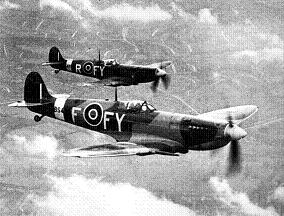![]() The Pacific War Online Encyclopedia
The Pacific War Online Encyclopedia
|
| Previous: Special Service Force | Table of Contents | Next: Spokane |

Supermarine Spitfire Mk.VB
| Crew | 1 | ||
| Dimensions | 36'10" by 29'11"
by 11'5" 11.23m by 9.12m by 3.48m |
||
| Weight | 5100-6785 lbs 1313-3078 kg |
||
| Maximum speed | 374 mph at 13,000
feet 602 km/h at 4000 meters |
||
| Climb rate | 54 feet per second 16.5 meters per second |
||
| Service ceiling | 37,000 feet 11,300 meters |
||
| Power plant | 1 1470 hp (1096 kW) Rolls-Royce Merlin 45 vee-12 liquid-cooled engine driving a three-bladed propeller. | ||
| Armament | 2 20mm Hispano fixed wing cannon 4 0.303 fixed wing machine guns |
||
| External stores | 1 500 lb (227 kg) bomb or drop tank | ||
| Range | 470 miles (760 km) on internal fuel | ||
| Production | 20,360 of all types from 8/38: | ||
| 1567 | Mk.I | ||
| 921 | Mk.II | ||
| 94 | Mk.VA | ||
| 3911 | Mk.VB | ||
| 2467 | Mk.VC | ||
| 100 | Mk.VI | ||
| 4010 | LF.IX | ||
| 1255 | F.IX | ||
| 400 | HF.IX | ||
| 140 | Mk.VII | ||
| 1658 | Mk.VIII | ||
| 100 | F.XII | ||
| 527 | F.XIV/E | ||
| 430 | FR.XIVE | ||
| 941 | PR photoreconnaissance conversions of all types | ||
| Variants |
Numerous variants. The Mark I was equipped with a 1030hp Merlin II and four .303 Browning machine guns. The IA upgraded to eight machine guns and a
bulged canopy.The
IB had two 20mm
Hispano cannons and four .303 machine guns. The IIA had a 1175hp Merlin XII and eight
.303, while the
IIB was armed
with two 20mm cannon and four .303. The
IV was an unarmed photoreconnaissance plane. The VA introduced the Merlin 45 and was
armed with eight
.303 The
VC was armed with a modular wing that allowed a choice of guns plus two
250lb
wing bombs. The VI
was a high-altitude
interceptor using a 1415hp Merlin 47, pressurized cockpit, two 20mm
cannon and
four .303s. The VII
used a 1660hp Merlin
61 with two-stage supercharger. The
VIII
was basically an unpressurized
VII. The IX was
basically a V with the Merlin
61 and a four-bladed propeller, pushing the speed up to 408 mph. It was developed
specifically to counter the FW-190 in Europe. The XI was a
photoreconnaissance
version using a 1760hp Merlin 63A; the X was a pressurized version of
the XI. The XII had
a strengthened airframe and a
1735hp Griffon engine. It was designed to be very fast at low altitude
(372 mph at 5000 feet). The
XVI had a
two-stage 2050hp Griffon Mk 65 engine and was typically armed with two
20mm and
two machine guns. The
XVI was a IX with
a 1705 hp Packard Merlin 266. The
XVIII
was derived from the XIV and carried more fuel. The XIV had a Griffon engine driving a five bladed propeller. It could reach 448 mph. |
||
The Spitfire is the legendary plane that
won the Battle of Britain.
Though more bombers were brought
down by Hurricanes, the
Spitfire was
better able to mix it up
successfully with the German
fighters.
Thus, when the first Spitfires arrived in the Pacific,
their pilots,
many of them aces, were confident that they could take on the Zero.
However, casualties were initially heavy
until the Spitfire pilots learned to respect the Zero and avoid taking
it on
its own terms. The
Spitfire also was handicapped
in this theater by its rather short range, acceptable for Europe but
not for
the far reaches of the Pacific.
The prototype first flew on 5 March 1936, and the first
production aircraft were ordered three months later. The design was
very advanced for its time, and proved sufficiently adaptable to remain
in production throughout the war and into the postwar era. A total of
over 20,000 of all models were produced, more than any other Allied fighter.
References
The Pacific War Online Encyclopedia © 2007-2008, 2010 by Kent G. Budge. Index